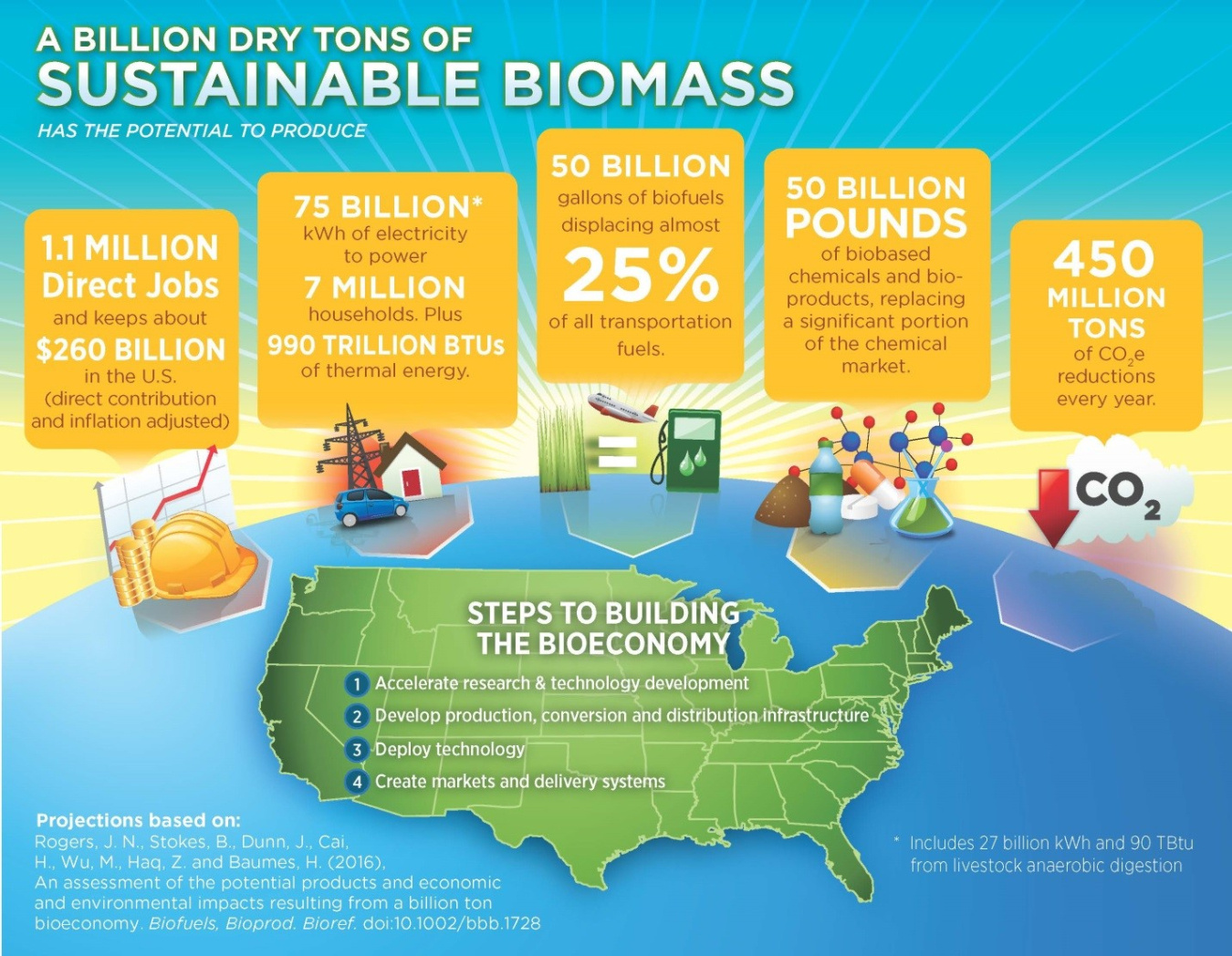
This infographic summarizes the production potential, as well as the economic and environmental outcomes, of utilizing 1 billion tons of biomass per year. To see the kinds of biomass that could constitute the bioeconomy, check out the <a href="https://youtu.be/EjdixWf1tYw?t" target="_blank">“Enabling the Billion-Ton Bioeconomy”</a> video.
One billion tons of biological material—that’s enough to fill a 16-foot flatbed truck stacked roughly up to the moon! But we wouldn’t have to “shoot for the moon” to produce this much biomass every year. According to the 2016 Billion-Ton Report, within the next 15 years (considering technology, prices, and demand), the United States has the potential to sustainably produce at least 1 billion tons of biomass annually, while continuing to meet demands for food, feed, industrial uses, and exports. This is about three times more than we currently use. As summarized in the graphic above, this would be enough to power 7 million homes and produce 25% of U.S. transportation fuels, including aviation fuels.
Although the market demand for transportation fuel has been filled by petroleum-derived gasoline and jet fuel, the federal government has long recognized the need to diversify our supply. The Energy Department’s Bioenergy Technologies Office has been hard at work strategically advancing technologies to make biofuels from non-food biomass resources cost-competitive for American consumers.
With the production potential established, we co-chaired an interagency team and recently published the article, “An Assessment of the Potential Products and Economic and Environmental Impacts Resulting from a Billion Ton Bioeconomy.” Our analysis, based on data in the 2016 Billion-Ton Report, illustrates that the United States has the potential to realize many economic and environmental benefits.
Economic outcomes
The United States could generate $260 billion in direct revenue and 1.1 million direct jobs in a wide range of sectors, including farming, plant operations, scientific research, and product and equipment design. Also, a flourishing bioeconomy with many products from a variety of sources would give the United States greater flexibility to accommodate market fluctuations.
Environmental outcomes
The United States could achieve production of a billion tons of biomass with minimal land-use change, while preserving soil quality. Energy crops such as switchgrass and miscanthus can grow on marginal lands and reduce nutrient runoff and erosion. Models predict that farmers would only need to utilize 6% of U.S. pastureland to grow enough energy crops to reach the 1 billion tons. Moreover, this has the potential to reduce life-cycle greenhouse gas emissions from the transportation sector by about 25%. Also, our study showed that about the same amount of water would be required to produce fuels from non-food biomass sources as from petroleum.
So how do we get there? Models in the 2016 Billion-Ton Report show that the two biggest potential biomass sources are agricultural wastes, which are available to be harvested or utilized already, and energy crops (planted only after meeting acreage requirements for conventional crops), which would require development. To achieve annual production and utilization of 1 billion tons of biomass, much work would need to be done along the entire supply chain, including expansion of biomass resources, adoption of innovative technologies to improve harvesting and conversion to end-use products, construction of biorefineries, workforce development, and policy implementation.
The U.S. Departments of Energy and Agriculture have complementary programs and core research areas that support the development of a sustainable bioeconomy, to help the United States to meet our society’s demands for energy, products, and power.
According to the 2016 Billion-Ton Report, within the next 15 years, the United States has the potential to sustainably produce at least 1 billion tons of biomass annually. This would be enough to power 7 million homes and produce 25% of U.S. transportation fuels, including aviation fuels.
The Bioenergy Technologies Office has been hard at work strategically advancing technologies to make biofuels from non-food biomass resources cost-competitive for American consumers.


